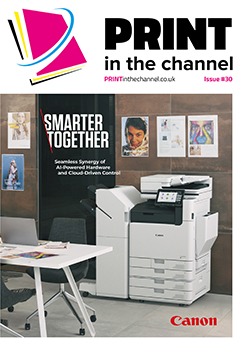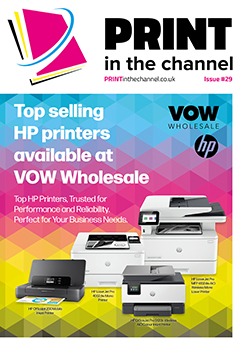The cloud print market is expanding rapidly as more businesses seek to take advantage of the benefits of it, including SMEs, but what are the barriers to cloud printing for SMEs and how can resellers help them to overcome these?
The past few years have been tough for businesses of all sizes, but small- to medium-sized enterprises in particular have found it difficult as they don’t have the resources to fall back on that larger businesses often do. As a result, many have been striving to find efficiencies where they can to keep up with their rivals.
One way to do that has been through adopting cloud printing solutions, especially in businesses where hybrid working has been established.
“The demand for cloud-based printing has continued to accelerate following the adoption of hybrid working by SMEs across various industries,” says Richard Stewart, workspace portfolio marketing manager at Canon UK & Ireland. “For SMEs, cloud printing has unlocked the ability to print remotely and stay connected to their team, from any device or location.”
Phillip John, category manager – office at Konica Minolta Business Solutions (UK), agrees that demand is growing among SMEs. “The feedback we have from our customers and partners reflects a growing interest from SME customers, with cloud print being particularly useful for those looking to support hybrid working and/or to easily and cost-effectively expand their device fleet,” he says. “Looking at the trends we would expect this to continue growing as SMEs become more aware of the flexibility benefits.
Arjan Paulussen, managing director, UK, Western Europe and English-speaking Africa at Lexmark, adds that SMEs are continually seeking innovative ways to enhance efficiency and adapt to the challenges and opportunities posed by hybrid working models. “This is where cloud printing steps in as a game-changer,” he says. “Cloud printing offers SMEs a lifeline to enhanced productivity and adaptability for the new way of work that empowers SMEs to thrive in the digital age.
“SMEs are increasingly recognising the value of cloud printing and there has been a notable rise in demand for cloud printing solutions, driven by the need for flexibility, scalability and cost-effectiveness. The benefits of cloud printing have been clearly recognised over the past few years because of changing working conditions and are now an imperative for business of all sizes.”
Cloud label printing
Paul Vogt, Loftware VP Partner Strategies, says that demand for cloud printing in the label sector is growing among SMEs too. “It is the fastest growing segment of the label printing sector,” he says. “Businesses of all sizes, SMEs included, must optimise their supply chains. They must meet growing demand and mitigate against ongoing disruptions and economic headwinds. Cloud printing helps them to meet the demands to scale, and to add a high degree of flexibility too. Cloud technology also delivers agile and reliable supply chain operations to mission-critical label printing.
“Labelling software providers are responding with out-of-the-box cloud label design print and manage functionality. Printer manufacturers are responding to the growing demand by adopting and driving cloud technology.
“Epson is the latest to announce that its label printers are cloud-connected, for example. Additionally, warehouse management system (WMS) providers are responding. Label printing is a critical function of such solutions, and all the leading WMS providers are moving to the cloud.”
Paul adds that customer demands for cloud print solutions in labelling may continue to evolve in response to changing business needs and technological advancements. For example, supply chains cannot afford recalls anymore. “Cloud labelling and printing helps to shore up labelling and eliminate data errors,” he says.
“Supply chains must be transparent. All participants in their supply chain need to see where products came from and where they are going to. Only cloud technology can deliver that completely.”
Sustainability is another consideration, Paul adds. “Today’s consumers see themselves as catalysts for change,” he says. “More of them are intertwining sustainability into their purchase decisions, effectively forcing SMEs to implement and use sustainable business practices that meet or exceed customers’ expectations around environmental, social and governance,” he says. “As they look to meet these needs, SMEs will turn to cloud technology for their label printing operations and gain higher levels of overall supply chain sustainability, improve product traceability, dramatically reduce label errors and much more.”
Clearing barriers
But that said, many SMEs have still not made the jump to cloud printing, in the office or for labels. “The prime barrier to cloud print adoption is a lack of awareness,” says Paul. “Small businesses don’t realise that cloud printing is as available as an app on your phone. It’s that easy! Cloud technology means that users can log in when and where they want to design, share and print supply chain labels. Businesses often think they need IT resources to implement cloud print technology, however this is not the case.
“Another concern that we see is with data security. In fact, data is more secure when printing from the cloud than when printing from a business’ own network. Cloud-based solutions that are built on platforms like Microsoft Azure are architected to be the most flexible and secure cloud computing environments available today.
Paul adds that some businesses also believe the cloud is expensive. “In fact, the opposite is the case,” he says. “Cloud reduces manpower hours, the burden on IT, and the need for extra PC and server hardware.”
Arjan adds that while most SMEs are recognising the value of moving their operations to the cloud, many still need help with hurdles. “This can depend on the business sector and region,” he says. “Notably, concerns around security, maintenance and costs are burdening SMEs.
“Added costs to a small business’ tech stack are always a concern to owners. However, moving to the cloud makes operations significantly more affordable for small businesses. Business owners need more awareness and education on the benefits of the cloud so that they are empowered to make decisions that will ultimately benefit them in the long run. SMEs who let concerns around security, maintenance and cost prevent them from moving their processes to the cloud are at risk of falling behind as their competitors embrace digital transformation.”
Security is key
Graham Foxwell, product marketing lead, Kyocera Document Solutions UK, says there are multiple barriers to cloud print adoption for SMEs, particularly for those who are trying to implement this themselves without support of a reputable cloud print provider. “The main barriers are security, lack of in-house IT expertise, Initial setup and ongoing costs, unreliable internet connections and legacy equipment, such as older printers/MFP’s,” he says.
He adds that there are steps that can be taken to ensure that solutions are fully secure. “Select a reputable cloud print service provider that has a strong track record in security,” he says. “In addition, ensure that data in transit and at rest is encrypted and there are strict access controls to limit who can access your cloud resources.”
There should also be regular back-ups of data, as well as system updates and security patches, along with data loss prevention measures to monitor and prevent unauthorised sharing of data, he adds.
Regular security audits and vulnerability assessments should also be part of a solution, along with the employment of endpoint detection and response technology, to provide continuous monitoring for suspicious activities or anomalies, Graham says.
Paul adds that leading cloud service providers, like AWS or Microsoft Azure, are architected to be the most flexible and secure cloud computing environments available today. “All cloud solutions that follow their security guidelines are leaning on the most secure data environments available,” he adds.
“If businesses want to build such security into their own networks, they need a dedicated (and expensive) team of certified security professionals that understand and implement best practices consistently and continuously. Most companies don’t have the resources to do it themselves – or buy it in. That’s why they choose to use solutions that lean on cloud service providers, like AWS or Microsoft Azure, which have already made and continue to make significant investments in security.
“All reputable cloud software providers also engage third party audits to certify the soundness of their security practices. These certifications include the likes of Service Organization Control 2, ISO27001 and National Institute of Standards and Technology. They assure consumers that the provider’s security practices, including preventative and responsive protocols, have been tested and certified as reliable.”
Reseller conversations
Security is one of the vital areas that SMEs are concerned about with cloud printing and is something that should be in conversations resellers have with customers about it. Although Paul says it isn’t about ‘selling’ cloud these days.
“Stop talking about cloud!” he says. “We know that businesses want to be able to log in from anywhere and without using a license key. They need remote set up, configuration, reporting and monitoring. All that and more is only available with cloud printing. So, don’t ‘sell’ cloud; just ask questions about what the customer needs – knowing that the answer always ends up in the cloud.”
Phillip adds that solution providers must provide resellers with all the information required to overcome any barriers that SMEs may perceive to have. “We know that security, ROI and performance are the main concerns of customers, so information has to be provided to alleviate these concerns,” he says. “Security white papers, the ability to demonstrate the performance and a clear ROI are all needed when selling cloud print solutions.”
Richard at Canon adds that a top priority for SMEs is access, which resellers need to be aware of. “Employees need to be confident they can access documents when and where they need them,” he says. “Additionally, as SMEs look to grow, the need for flexibility and security will only become more urgent. Adopting a cloud-based ecosystem can create momentum towards a future-proofed business, but there are also concerns about the risks involved in migrating data to the cloud.
“Here, the responsibility falls not only on resellers to recommend easily navigated solutions, but also on businesses to practice responsible management of their cloud ecosystem. This should be an ongoing conversation between resellers and their customers, regularly monitoring cloud solutions for updates and training employees to use software safely and securely.
“As a result, it’s crucial to invest in a trusted print provider, as it is not always a case of one size fits all. When needed, an SME’s multifunction printer can become single access, providing an extra layer of protection between the data and the rest of the network.”
Future
Looking to the future, the consensus is that demand for cloud printing will continue to grow. “As SMEs look to drive their digital transformations forward and modernise their workflows, the demand for cloud printing will only continue to increase, offering more flexible and secure working arrangements in an ever-evolving business,” says Richard.
Graham adds that currently customers have a range of demands. “Such as for remote printing capabilities with the ability to print documents from anywhere, and from mobile devices and tablets,” he says. “Also customers are looking for solutions that can adapt to their changing needs without requiring significant infrastructure changes, and the ability to scale up or down easily, cloud printing solutions that help reduce paper waste and lower carbon footprint, meeting customers’ environmental commitments and solutions that need minimal training.”
In terms of security, Graham says customers are seeking robust security features, including encryption, access controls and compliance with data protection regulations like GDPR, as well as zero trust modelling – providing extra security for organisations that require it.
“Customers also want pricing models that are transparent and cost-effective, allowing them to pay for what they use and improved tracking and reporting on environmental impact – eco-friendly solutions data analytics – who’s printing/scanning what, where and when,” he says.
“It’s likely that these demands will continue to evolve, with the need for hybrid print environments that combine cloud and on-premises printing for greater flexibility and control.”
Arjan adds that cloud printing will continue to adapt with emerging technologies such as artificial intelligence and machine learning, which will influence customer expectations.
Phillip says that many customers are looking for cloud print solutions that will support their hybrid working needs, enabling employees to remain productive wherever they are working. “With inflation continuing to rise, there is also a focus on ROI and using cloud print to reduce unnecessary print costs and wastage. Both these trends are likely to continue for at least the next 12-18 months as SMEs look to stay flexible and agile to meet the evolution of their markets.”










